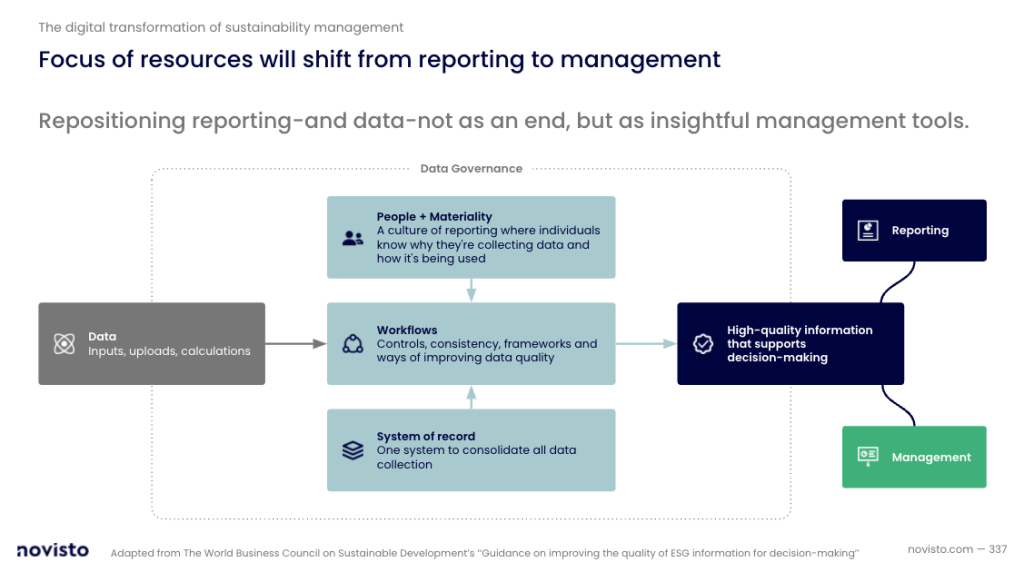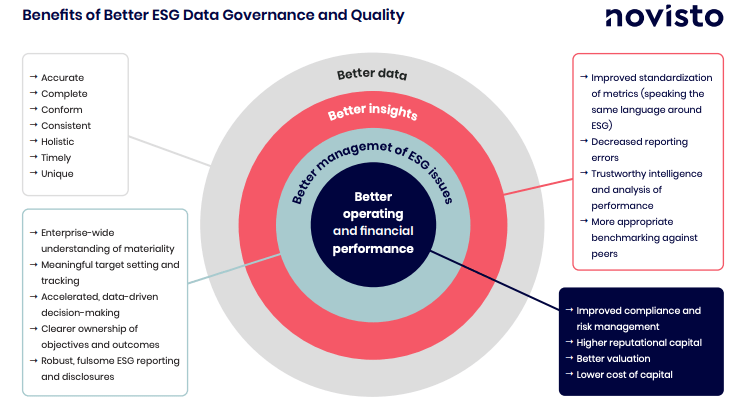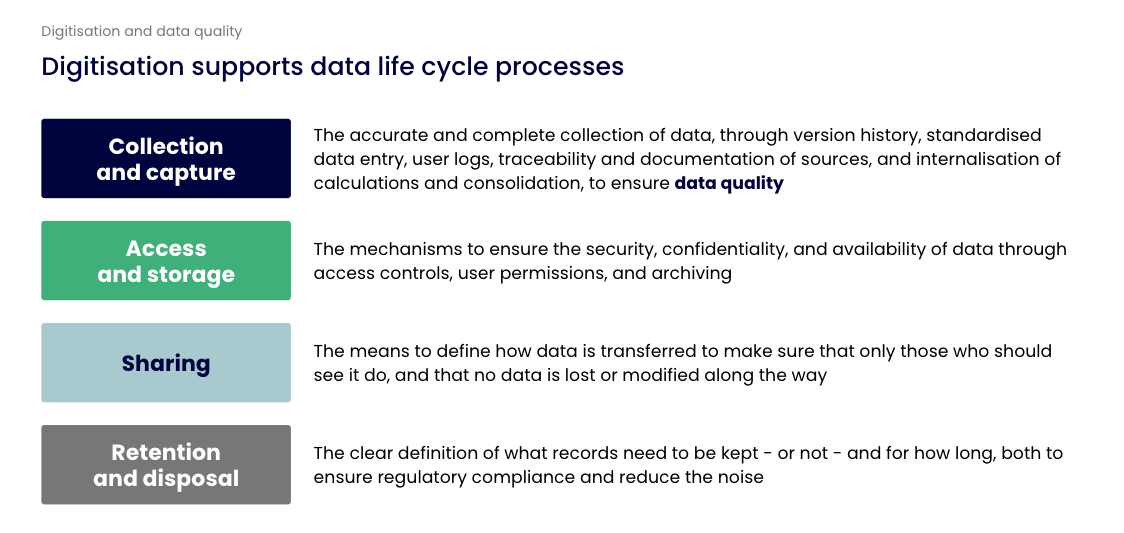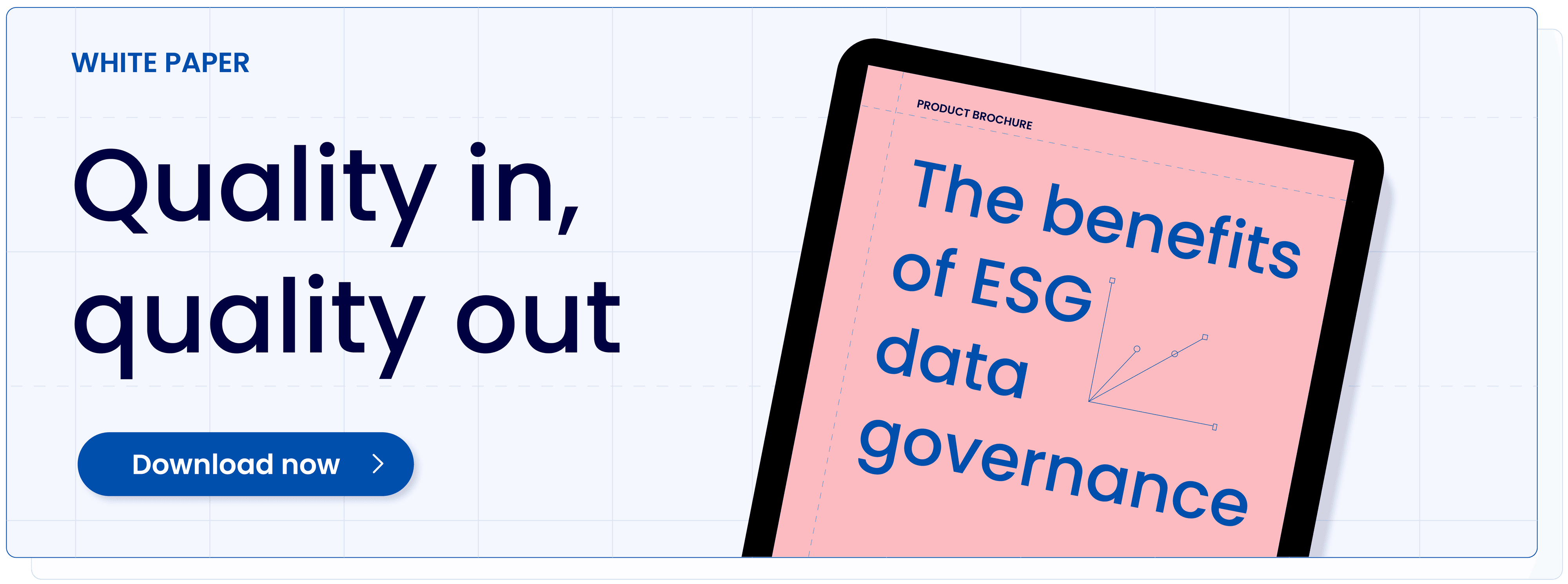
*This blog post was initially published on Sept 29th, 2022
The purpose of corporate data is to allow both management and stakeholders to make decisions and take actions that maximize benefits to the company and its stakeholders. It is a foundational building block of managing and reporting on business-critical issues. Poor data leads to poor decisions and even poorer results—as the popular computer science saying goes: garbage in, garbage out (“GIGO”). Ultimately, effective ESG data management relies on quality inputs.
As regulatory demands grow, ESG reporting is evolving to match the structure and rigor of financial disclosure. Companies now face rising expectations for investment-grade, externally audited ESG data, making effective data management a necessity, not a choice.
While the digitization of sustainability data collection and reporting (including ESG data management) is still relatively new, the rise in requests for investment-grade, externally audited ESG information requires companies to adopt effective ESG data management practices.
Thankfully, these are already well documented.
What is ESG data management, exactly?
Data management is the practice of collecting, keeping, and using data securely, efficiently, and cost-effectively. Technology giant Oracle defines the goal of data management as helping “people, organizations, and connected things optimize the use of data within the bounds of policy and regulation so that they can make decisions and take actions that maximize the benefit to the organization.” Good ESG data management helps ensure that users trust and have confidence in the data to be fit for its intended purpose, without the need for manual alignment or data reconciliation.
In corporate sustainability, good ESG data management helps ensure that users trust and have confidence in the data to be fit for its intended purpose, without the need for manual alignment or data reconciliation. However, establishing a clear and comprehensive data governance framework is a critical first step for effectively managing your ESG data, material issues, and overall business performance.
So, what is ESG data governance?
Although sometimes used interchangeably with ‘ESG data management’, ESG data governance is more holistic because it is an important business area that requires both policy and oversight.
According to the Data Governance Institute, “data governance is a system of decision rights and accountabilities for information-related processes, executed according to agreed-upon models which describe who can take what actions with what information, and when, under what circumstances, using what methods.” This is similar to how executive teams (management) interact with and implement the vision of the board of directors (governance), an oversight relationship that takes the form of programs and policies.
Ultimately, good data governance is the foundation of high-quality data. It standardizes the way an organization uses data to improve business outcomes, ensuring that the data is well-managed, used, and disposed of. With a robust governance framework in place, companies can better understand their sustainability performance, manage issues efficiently, and inform stakeholders appropriately.
The basics of ESG data management: Data user vs. data owner - which one are you?
A data user is any person (stakeholder), application, or process that receives and uses data. They determine the characteristics they require of this data and their expectation of quality. They need to know that the data is fit for their intended use.
A data owner has overall accountability for the meaning, content, quality, and distribution of a given set of data. This includes how the data is defined, manufactured, identified, maintained, delivered, and consumed.
The seven dimensions of data quality
In the context of corporate sustainability data, the many data users and owners make quality more difficult to define and control. However, good ESG data is like any good business dataーthe same rules apply.
Putting the ESG lens aside, the concept of data quality is pretty well established. According to the Enterprise Data Management Council, the quality of data can be evaluated against defined dimensions as well as against the business processes associated with its production and collection. Their seven dimensions of data quality are:
- Accuracy measures the precision of data. It can be measured against either original documents or authoritative sources and validated against defined business rules.
- Completeness measures the existence of required data attributes in the population of data records.
- Conformity measures how well the data aligns to internal, external, or industry-wide standards.
- Consistency provides assurance that data values, formats, and definitions in one data population agree with those in another population.
- Coverage refers to the breadth, depth, and availability of data that exists, and whether it is missing from a data provider.
- Timeliness measures how well content represents current market/business conditions as well as whether the data is functionally available when needed.
- Uniqueness refers to the singularity of records and or attributes. The objective is a “single source of truth” of data.
What is the purpose of ESG data?
All of these dimensions are designed to ensure that data is fit for its intended purposeーin other words, good enough to do the job it was designed to do.
Whether or not your business data is ESG-related, its purpose is multifold:
- Measure performance on issues that matter to the business.
- Analyze performance over time, against targets, and against peers to inform the management of these issues.
- Allow stakeholders to make well-informed decisions (e.g., whether or not to buy a company’s products or to become an employee).
- Enable investors and other capital providers to decide on the most efficient flow of capital towards their intended or desired use, at the appropriate price.
Today, the relatively poor quality and reliability of ESG data remains a significant challenge to using it effectively. However, the digitization of data collection, when paired with good ESG data management practices, will enable data quality and make it seamless for any intended purpose.

What does data quality mean for your organization?
Not all data requires the same level of quality. We can think of the level of data quality in terms of the number of dimensions for which a given data point must be of “good” quality - a data point may be of “good” quality in one dimension but not another.
For example, if you put a phone number in the field for a postal code, the data will be at 100% quality for the completeness dimension (meaning the field is filled) but at 0% for the accuracy dimension.
In other words, data quality is context-specific (think: what is the data’s intended purpose?). This context determines which dimensions are relevant to use in measuring and determining data quality. For ESG data, the quality needed differs based on the type of data. For example, data for disclosure to investors may not require the same level of granularity (or quality) as data used internally in an exploratory context.

Data quality should also be measured and managed throughout its entire lifecycle because data flows and interactions with other data may alter the level of quality. For example, if numbers in a data set are truncated to integers following a transfer to a data warehouse (rather than to two decimal places, as they were originally), their quality may be impaired. You need to implement controls to monitor ESG data quality throughout its life cycle and assign people to remediate quality issues as they arise.
How to leverage good ESG data governance and strategy
Like anything else governance-related, data governance should be embedded in an organization’s governance structure and aligned with the current way of overseeing the rest of the company. The best way to leverage good data governance is by making sure it contributes to the strategy and the objectives of your organization. Ensuring proper data quality serves to improve the reliability and credibility of reporting; it also serves to improve management functions.
As companies strive to become data-centric, data governance can become a key component of larger initiatives such as digital transformation or change management. It’s part of a continuous improvement process similar to that of embarking on a sustainability journeyーone that requires shifting the cultural mindset and laying a strong foundation to handle and leverage information.
And it’s no easy task; a survey of hundreds of decision-makers conducted by Wharton Business School found that only 24% of senior decision-makers passed the test for data literacy. Making your company more data literate requires training employees, developing capabilities, and creating a culture where decisions are made based on data and not purely on gut feelings.
Responsibility and accountability of ESG data
An important part of data governance is the definition, documentation, and communication of roles and responsibilities, as well as accountability over data. Since data has become ubiquitous, everyone in an organization works to capture, access, manage, or transform data at some point. Therefore, everyone has some degree of responsibility over the data life cycle and quality.
This is particularly true with sustainability-related issues, which are inherently multidimensional. This means that ESG data lives in many different business functions within a companyーand nearly everyone may impact ESG data in some way.
If everyone is responsible for data quality, who is actually accountable?
Legislation around the world, including privacy regulations, increasingly requires someone to officially take on a role with direct accountability for data in an organization. For example, GDPR requires a company to have a Chief Privacy Officer, while the province of Québec mandates a corporate Chef de l’information (Chief Information Officer).
Corporate boards are explicitly adding data governance to committee charters—or even creating whole data governance committees—and the topic is regularly added to the directors’ agenda. This isn’t particularly surprising given the notable rise in sustainability committees at the board level, an important trend that we highlight in The top 5 ESG developments of 2024. Reflecting this shift, consulting firm McKinsey advises financial institutions to “create a cross-functional steering committee for ESG data governance—including leaders from the business, technology, data, risk, and finance functions—with joint accountability and decision-making processes.”
As organizations grapple with ongoing ESG reporting challenges, dedicated roles within both the sustainability and finance functions are emerging to manage data governance structures. For instance, PepsiCo has established a team within its Global Sustainability Office to ensure data accuracy and consistency while driving accountability across the company.
Then, there’s the rise of what Forbes has dubbed “a job of the future”—that of the ESG controller. Trellis (formerly GreenBiz) notes that this title was virtually non-existent just two years ago, yet today, more than 50 Fortune 100 companies have ESG controllers on their payroll. A key driver? The rise of regulated or ‘third wave’ reporting, states the Illinois CPA Society, who also underscore their critical leadership in data governance monitoring. According to the Thomson Reuters Institute, a core responsibility of ESG controllers is to build and maintain robust data management systems, ensuring accuracy, consistency, and integrity across ESG disclosures, typically within the finance function.
Lastly, some companies have additional data governance specialists on staff to support the person acting as a Chief Data or Chief Privacy Officer. Since reporting on ESG and sustainability is a relatively new practice, these positions are especially critical for overseeing ESG data quality alongside other data collection and reporting at an organization.
Supporting ESG data management through digitization
The digitization of data collection into a single, centralized system of record and the automation of data processing and reporting will go a long way to improving the quality of ESG data throughout the data lifecycle. Digitization will help make data easier to use for its intended purpose and create a virtuous circle of “quality in, quality out” (QIQO).
ESG data management life cycle: Collection and capture
Today, corporate data is still often collected manually, especially non-financial, sustainability-related data. According to KPMG's 2024 Sustainability Organization Survey, 47% of organizations still rely on spreadsheets for their ESG data management. But manual processing of data is cumbersome and generally difficult to control or monitor. What’s more, it can increase the risk of poor or low-quality data, fragmented information, and inaccurate ESG disclosures, potentially leading to greenwashing.
As stakeholder demands for transparency grow, companies must invest in robust data systems to ensure reliable, verifiable reporting. Automating data ingestion through digital tools not only speeds up the process but also allows for validation controls to ensure consistent and high-quality ESG data along the various dimensions mentioned above.
ESG data management life cycle: Access and storage
Proper access and storage of data protects confidentiality and prevents unwanted modifications to data, which both contribute to data integrity and security and ensures the availability of data. Access controls include logs that keep track of “who accessed what” and “who changed what”. Integrity controls protect data against unwanted alterations or keep track of previous versions.
Availability is the capacity to make the data available in a timely fashion to those with appropriate access levels. Compared to physical repositories, digital repositories make retrieving ESG data easier, faster, and more secure.
ESG data management life cycle: Sharing
Sharing controls and transfer agreements serve to define both data ownership and how data is transferred or passed on; this protects its confidentiality and integrity, ensuring that no data is lost or modified along the way. This also includes metadata, which is simply data that describes other data, such as a source or fiscal period.
When ESG data is digitized and consolidated in an organized system of records, it becomes possible to quickly give users access to what they need rather than send multiple copies out to different people.
ESG data management life cycle: Retention vs. disposal
The bigger the dataset, the more difficult it is to store. Whether or not to keep records (and if so, for how long) needs to be clearly defined. While some data assets should probably be kept forever, others should not. This is one (albeit rare) case where technology could make things “worse”, as the decreasing costs of data storage and increasing capacity of data analytics result in companies hanging onto their data indefinitely.
This is to be avoided, as it increases the noise ratio, gives rise to duplicates, and reduces the certainty of a single source of data truth. In some instances, it may even be prohibited by law. For example, companies cannot retain personal data beyond a certain amount of time, else risk considerable fines for doing so.

How ESG data management software, like Novisto, can help
Many tools exist to try and help companies effectively collect, manage, and use ESG data.
Novisto helps companies create a “single source of truth” for ESG data , making it quick and easy to collect, share, and use. Our platform ensures that corporate ESG data, workflows, and reporting are trusted (read: auditable, like financial data), efficient (automated and streamlined), and insightful (contextualized, with clear guidance for decision-making).
Closing the loop on ESG data management, quality, and governance
Ultimately, the benefits of digitizing the data life cycle processes for your organizationーgreater data quality, certainty, efficiency, and integrityーare critical to a successful data governance strategy. With quality, centralized ESG data and good ESG data management practices, your company will be able to better understand, share, and act on its sustainability performance.
Discover the potential of your ESG data. Download our white paper, Quality In, Quality Out: The Benefits of Better ESG Data Governance, today.
Some of the contents of this blog are based on a previous Novisto article co-authored by Catherine Nadeau, Senior Manager of Information and Data Governance at KPMG in Canada.


